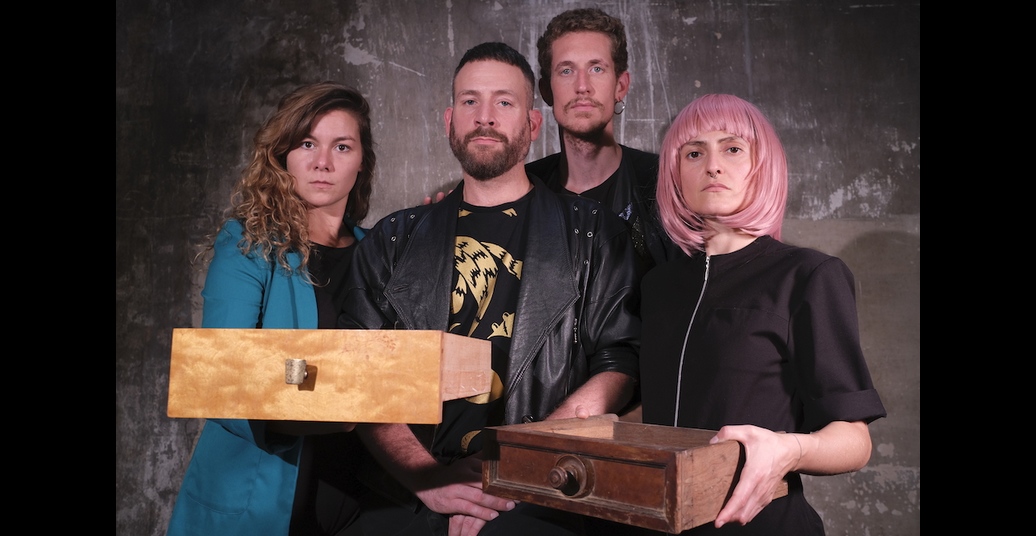Four deaf performers, Steve Stymest, Jan Kress, Rita Mazza, and Athina Lange, create a musical, “Vier”, using the richness and diversity of German Sign Language and Visual Vernacular to access music from a different angle. “Vier – A Visual Musical in Sign Language” premiered 17 December 2019 at Sophiensæle.
Have you ever looked at your hands closely? They can be creatures of their own. Bearing so many traces, so many characteristics, displaying sophistication and information, covered in lines and points, they can say a huge amount about a person. In fact, they can literally speak. This evening, I find myself in the woods of the speaking hands of the many deaf audience members and the four deaf performers of “Vier” in the Kantine at Sophiensæle.
The piece begins with music and the four performers move in sync with it. I try not to become preoccupied with comprehending exactly how they do this (sometimes the best thing is to simply accept), but instead try to imagine how this scene feels to the many deaf viewers who were conversing in sign language before the show. I quickly accept it as impossible, seeing as I am not them, and allow myself to step into a room of the imagination while trying to avoid fetishising a world that I am not a part of.
The lights change and the music stops. From this point on, I am the one who cannot “hear.” The performers’ arms and hands move with articulate and rhythmic gestures. I do not know when these movements are transmitting an explicit meaning, and when they are simply moving. When I hear laughter from those audience members who understand, or feel some viewers leaning in closer with concentration, I assume a certain meaning that I cannot guess at is being conveyed by the expressive flow of hands. I am delighted by this unknowing. One of my favourite forms of travelling is to visit somewhere, alone, where I do not speak the language. The freedom of not understanding or trying to be understood allows me to simply exist, observe, and absorb. I feel this freedom while sitting here immersed in this unfamiliar world of communication.
In the programme, the makers write about using the diversity of sign language to expand the boundaries of music. They make use of the so-called ‘disadvantage’ of their deafness to create a poetic experience. I think about my own ‘disadvantages’ and how I can use them to design poetic disorientation. For instance, I have absolutely no sense of direction. If I walk down a street, go into a shop and come back out again, I would not be able to tell you which direction I came in from. Using this personal feature as a tool, I let myself get completely lost, slowly strolling and enjoying the process, until quite soon, I have no clue where I am at all. Witnessing the musical, I feel something similar. I feel as though I am in the middle of an unknown forest, surrounded by trees, each of which have names that I am unfamiliar with. The thick undergrowth is the layers of moving hands, expressive bodies, and the distinct air of sensitivity that emanates from these bodies, and the way in which they use touch as a natural means of interaction. I find this feeling of ‘lost-ness’ comforting, as if I am engulfed in a cocoon of gentle light and the sound of the wind brushing the leaves.
To listen is oftentimes to love. One listens more attentively when one is in love with the subject at hand. The type of listening I am referring to is broad in definition; one can ‘listen’ to unspoken silences between words, a tiny shift in someone’s gaze, a certain quality of touch. There is a reason why I ‘listen’ assiduously to every shift in the musical and in the atmosphere of the room: I am in love with hands. To be in the presence of so many articulately moving hands is enchanting to the point of being almost dizzying. For the duration of a solo within the piece, a spotlight shines on a pair of hands. They move diligently and with passion for a length of time. The effect on me is hypnotic.
Why am I in love with hands? Maybe it is because I play musical instruments. Playing the piano is one thing I do only for myself, and when I play, I feel that I am expressing myself authentically. It is a form of expression without spoken words. Instead, it consists of the intentional movement of fingers pressing keys, the vibration of varying nuances of sound, the interplay of velocity, strength, and breath between the notes. It is a physical experience that delivers emotion through touch, and that produces sound. It is a space of expressiveness that moves me.
I observe that “Vier” appears to be taking place within the frame of a similar specific sensibility of detailed physical ‘listening’ and expressing. I sit in the valleys of dexterously moving hands, and it makes me want to disappear into them, as if each note produced by pressing the keys on the piano has been replaced by the hands themselves. I feel a warm rush of tenderness, as though in the moment when a lover buries their head between my breasts, and falls asleep. Their breathing, the air coming out of their mouth, transforms into an intimate landscape of sound. The air touches that soft part of my skin over my heart where the two halves of my ribcage meet, and produces warmth. This warmth seeps under my skin as touch and memory.
Towards the end of the musical, the performers pull out four powerful portable speakers that emit loud dance music. They start to dance and invite the audience to dance with them. For the next five minutes or so, a dance party ensues and the speakers are passed around the audience. “Can some ‘deaf’ people hear when they bring loud sound very close to their ears?”, I wonder. While I am engrossed in handling the speaker, I feel a sudden shift in the air. It is as though I were standing in a forest and found myself in a silent spot between winds when all the leaves suddenly fall silent. I look up. The audience have surrounded the performers, making a big circle around them. They all have their arms extended over their heads and are waving their fingers and palms gently back and forth, as though they are leaves waving in the wind. Silent applause. I feel a moistening in the air as this collective energy is released through the forest of hands. Am I lost in a forest that is right by an ocean? When this silent spot in between winds falls over the woods, the sound of the ocean waves are suddenly amplified. “Oh,” I think, “the water has been here the entire time!” And in this moment of silent applause, I feel the water rushing in.




